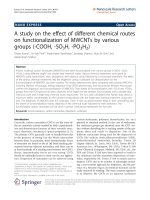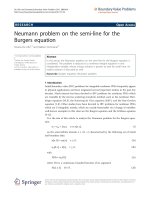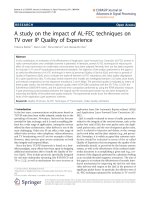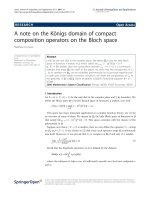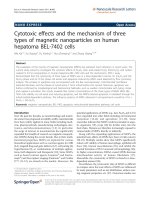Báo cáo hóa học: " Excitonic effects on the second-order nonlinear optical properties of semi-spherical quantum dots" pdf
Bạn đang xem bản rút gọn của tài liệu. Xem và tải ngay bản đầy đủ của tài liệu tại đây (261.35 KB, 6 trang )
NANO EXPRESS Open Access
Excitonic effects on the second-order nonlinear
optical properties of semi-spherical quantum dots
Jefferson Flórez
*
and Ángela Camacho
Abstract
We study the excitonic effects on the second-order nonlinear optical properties of semi-spherical quantum dots
considering, on the same footing, the confinement potential of the electron-hole pair and the Coulomb interaction
between them. The exciton is confined in a semi-spherical geometry by means of a three-dimensional semi-
parabolic potential. We calculate the optical rectification and second harmonic generation coefficients for two
different values of the confinement frequency based on the numerically computed energies and wavefunctions of
the exciton. We present the results as a function of the incident photon energy for GaAs/AlGaAs quantum dots
ranging from few nanometers to tens of nanometers. We find that the second-order nonlinear coefficients exhibit
not only a blue-shift of the order of meV but also a change of intensity compared with the results obtained
ignoring the Coulomb interaction in the so-called strong-confinement limit.
Introduction
Nonlinear optic al properties of semiconduc tor quantum
dots have attracted considerable interest due to their
several potential applications [1-4]. In particular, sec-
ond-order nonlinear optical properties, such as non-
linear optical rectification (OR) and second harmonic
generation (SHG), have received special theoretical [5-8]
and experimental [9,10] attention due to their magni-
tudes being stronger than those of high-order ones,
making them the first nonlinear optical effects experi-
mentally observed.
The confinement of carriers provided by a quantum
dot is well described by a parabolic potential when only
the lowest excited states of the carriers are considered.
However, self-assembled quantum dots growth in the
laboratory usually exhibit asymmetrica l shapes that
ensure the generation of nonlinear optical effects. In
order to model these asymmetries, an asymmetrical
potential is required.
Recently, several a uthors [5,6,8] studied the effects of
an exciton on the second-order nonlinear properties in
one-dimensional semi-parab olic quantum dots. Using
analytical approximate results, they showed that the
excitonic effects enhance significantly the OR and SHG
coefficients. They used the so-call ed strong-confinement
limit, ignoring in this way the C oulomb interaction
between electron and hole because of the quantum dot
dimensions are smaller than the effective Bohr radius,
and finding that the excitonic effect reduces itself to an
effective-mass model in one particle scheme.
In this study we find eigenenergies and eigenstates of
an exciton in a semi-spherical quantum dot solving the
corresponding three-dimens ional Schrödinger equation
using a finite elements method and t aking into account
both the confinement a nd Coulomb potentials of the
electron-hole pair. We present the OR and SHG coeffi-
cients as a function of the incident photon energy with
and without Coulomb potential. Our results show that
energy and intensity of the peaks in the second-order
nonlinear optical coefficients change when Coulomb
interaction is introduced.
This article is o rganized as follows. In “Theory” sec-
tion, we present the characteri stic quantities of t he har-
monic and Coulomb potentials, and the definitions of
the weak- and strong-confinement limits in terms of
these parame ters. In addition, we present the analytical
expressions for the optical nonlinearities, such as OR
and SHG, obtained by t he density matrix formalism. In
“Results” section, we show the OR and SHG coefficients
with and without Coulomb interaction as a function of
the incident photon energy for two quantum dot sizes.
We also give account of the changes presented by the
* Correspondence:
Departamento de Física, Universidad de los Andes, A.A. 4976, Bogotá, DC,
Colombia
Flórez and Camacho Nanoscale Research Letters 2011, 6:268
/>© 2011 Flórez and Camacho; licensee Springer. This is an Open Access article distributed under the terms of the Creative Commons
Attribution License ( /by/2.0), which permits unr estricted use, distribution, and reproduction in
any medium, provided the original work is properly cited.
second-order nonlinear coefficients focusing in the role
played by the Coulomb interaction. Conclusions are
summarized in final section.
Theory
The effective-mass Hamiltonian for the electron-hole
pair in the three-dimensional quantum dot reads [11]
H =
p
2
e
2m
∗
e
+ V
(
r
e
)
+
p
2
h
2m
∗
h
+ V
(
r
h
)
−
e
2
4πε|r
e
− r
h
|
,
(1)
where
m
∗
e
and
m
∗
h
are the effective masses of the elec-
tron and the hole, respectively, ε is the background
dielectric constant and V (r
i
) is the three-dimensional
semi-parabolic potential that we define as
V
(
r
i
)
=
⎧
⎨
⎩
1
2
m
∗
i
ω
2
0
r
2
i
,0≤ θ<
π
2
,
∞,
π
2
≤ θ ≤ π,
(i =e,h).
(2)
The angle θ is the usual polar angle in spherical coor-
dinates, and ω
0
the oscillator frequency considered in
this study the same for the electron and the hole. The
potential defined in Equation 2 confines the exciton in
the upper half of a sphere, i.e., the quantum dot has a
semi-spherical shape.
Hamiltonian (1) c an be separ ated in terms of center-
of-mass and relative coordinates, respectively,
H =
P
2
2M
+
1
2
Mω
2
0
R
2
+
p
2
2
μ
+
1
2
μω
2
0
r
2
−
e
2
4πε|r|
,
(3)
where
M = m
∗
e
+ m
∗
h
is the total mass, and
μ = m
∗
e
m
∗
h
/
M
is the reduced mass. The center-of-mass
and relative position coordinates are defined as usual,
R
=
m
∗
e
r
e
+ m
∗
h
r
h
M
, r = r
e
− r
h
,
(4)
with t he corresponding momenta P =-iħ∇
R
and p =
- iħ∇
r
in terms of p
e
and p
h
,
P = p
e
+ p
h
, p =
μ
m
∗
e
p
e
+
μ
m
∗
h
p
h
.
(5)
The explicit separability of the center-of-mass and rela-
tive coordinates in Equation 3 lead to the following total
envelope wave function and total energy for the system:
Ψ
(
r
e
, r
h
)
= Φ
(
R
)
φ
(
r
)
,
(6)
E = E
R
+ E
r
.
(7)
The center-of-mass part of Hamiltonian (3) is a three-
dimensional semi-parabolic oscillator that can be solved
analytically. Therefore, the problem is now reduced to
solve the relative motion Hamiltonian:
H
r
=
p
2
2
μ
+
1
2
μω
2
0
r
2
−
e
2
4πε|r|
.
(8)
Hamiltonian (8) has been solved analytically in two
limiting cases (strong and weak confinement) for one-
dimensional quantum dots. The eigenf unctions and
eigenvalues are presented in references [5] and [8]. In
one-dimensional case, the confinement potential also
impos es constra ints to spat ial coordinates, resulting in a
hydrogen-like (asymmetric-harmonic) reduced particle
Hamiltonian for weak (strong) limit.
The harmonic potential in Equation 8 defines both the
size L of the quantum dot,
L =
¯
h
μω
0
,
(9)
and the energy quanta ħω
0
due to confinement, which
is related to L by
¯
hω
0
=
¯
h
2
μ
L
2
.
(10)
On the other hand, the Coulomb potential defines the
effective Bohr radius
a
∗
0
and the effective Rydberg energy
R
∗
of the electron-hole interaction,
a
∗
0
=
4πε
¯
h
2
μ
e
2
,
(11)
R
∗
=
e
2
4πεa
∗
0
=
μe
4
¯
h
2
(
4πε
)
2
.
(12)
The strong-confinement limit is established when
L a
∗
0
, or equivalently
¯
hω
0
R
∗
,andtheweak-
confinement limit when
L a
∗
0
,or
¯
hω
0
R
∗
.
The second-order nonlinear optical coefficients can be
obtained by density matrix approach and perturbation
expansion method [12,13]. The expression for the OR
coefficient, within a two-level system approach, is given
by [5,6]
χ
(2)
0
=4
e
3
σ
s
ε
0
¯
h
2
μ
2
01
δ
01
×
ω
2
01
1+
T
1
T
2
+
ω
2
+
1
T
2
2
T
1
T
2
− 1
(
ω
01
− ω
)
2
+
1
T
2
2
(
ω
01
+ ω
)
2
+
1
T
2
2
,
(13)
where e is the electron charge, s
s
is the density of
electrons in the quantum dot, T
1
is the longitudinal
relaxation time, T
2
is the transverse relaxation time, and
μ
01
= |
ψ
0
|r|
ψ
1
|
,
(14)
Flórez and Camacho Nanoscale Research Letters 2011, 6:268
/>Page 2 of 6
δ
01
= |
ψ
1
|r|
ψ
1
−
ψ
0
|r|
ψ
0
|
,
(15)
ω
01
=
E
1
− E
0
¯
h
.
(16)
For the resonance condition
¯
hω ≈ E
1
− E
0
,
(17)
there is a peak intensity given by (1/T
1
≪ 1/T
2
≪
ω
01
)
χ
(2)
0,max
=2
e
3
σ
s
T
1
T
2
ε
0
¯
h
2
μ
2
01
δ
01
.
(18)
The SHG coefficient in a three level system is [8]
χ
(2)
2ω
=
e
3
N
ε
0
×
μ
01
μ
12
μ
20
(
¯
hω − E
10
− i
¯
hΓ
10
)(
2
¯
hω − E
20
− i
¯
hΓ
20
)
.
(19)
where N is the density of carriers in the quantum d ot,
E
ij
= E
i
- E
j
, Γ
10
= Γ
20
= Γ
0
are the relaxtion rates, and
μ
ij
= |
ψ
i
|r|ψ
j
|
,
(20)
Under the double resonance condition, i.e., ħω ≈ E
10
≈
E
20
/2, the intensity of the peak is given by
|χ
(2)
2ω,max
| =
e
3
N
ε
0
μ
01
μ
12
μ
20
¯
h
2
Γ
2
0
.
(21)
and its energy by
¯
hω ≈
E
20
+2
E
10
4
.
(22)
Results
In this study, the results are presented for a GaAs/
AlGaAs structure. We have used the following para-
meters in the c alculations:
m
∗
e
=0.067m
0
,
m
∗
h
=0.09m
0
(m
0
is the mass of a free electron) [4], T
1
=1ps,T
2
=
0.2 ps [12], s
s
=5×10
24
m
-3
[5], ε = 12.53, Γ
0
=1/
0.14ps
-1
, N =3×10
16
cm
-3
[8].
In Figure 1, we plot the characteristic lengths and
energies for the confined particle in a GaAs/AlGaAs
quantum dot as a function of the confinement frequency
ω
0
.
a
∗
0
and
R
∗
are i ndependent on ω
0
because they are
related t o the Coulomb potential. In Figure 1a, we can
see that the lengths L and
a
∗
0
are of the same order of
magnitude for a confinement frequency around ω
0
=1×
10
13
s
-1
. In Figure 1b, we observe that also ħω
0
and
R
∗
show similar values around ω
0
=1×10
13
s
-1
. For
this reason, we conclude that, in this frequency range,
neith er the strong-confinement li mit nor the weak limit
can be assumed because both interactions, harmonic
and Coulomb, are important. Therefore, we propose a
numerical t echnique to calculate eigenen ergies and
eigenstates of Hamiltonian (8), considering the harmo-
nic and Coulomb potentials.
With the aim of exploring the nonlinear behavior at
higher frequencies, i.e., when the quantum dot size is
smaller than in the previous case, we choose ω
0
=2×
10
14
s
-1
, in which the quantity L is less than
a
∗
0
,orħω
0
is greater than
R
∗
, differing in both cases by one order
of magnitude as can be seen in Figure 1. Because of this
difference, several authors [5,6,8] used the strong-con-
finement limit as a satisfactory approximat ion in the
case of small quantum dots. Accordingly with Equation
9, the frequencies ω
0
=1×10
13
s
-1
and ω
0
=2×10
14
s
-1
defineaquantumdotsizeofL = 17.4 nm and L =
3.9 nm, respectively. This means that our results are sui-
table for the current quant um dot sizes that range from
few nanometers to tens of nanometers.
We find numerically eigenenergies and eigenstates of
Hamiltonian (8) by a finite elements method for the two
frequencies mentioned above. We have used the soft-
ware COM-SOL Multiphysics, which offers the possibi-
lity of defining a geometry, in this case the upper half of
a sphere, and to solve the time-independent Schrödinger
equation with appropriate boundary conditions.
Figure 1 Characteristic (a) lengths and (b) energies for the
confined particle in a GaAs/AlGaAs quantum dot as a function
of the confinement frequency. The red (black) lines correspond to
L and ħω
0
(
a
∗
0
and
R
∗
), respectively.
Flórez and Camacho Nanoscale Research Letters 2011, 6:268
/>Page 3 of 6
The terms involving quantum states and energies in
Equations 13 and 19 are found using the eigenstates and
eigenenergies previously calculated. The OR and SHG
coefficients are shown in Figures 2 and 3, respectively.
Figures 2a and 3a correspond to ω
0
=1×10
13
s
-1
,and
Figures 2b and 3b to ω
0
=2×10
14
s
-1
. In each figure,
we present the corresponding nonlinear optical coeffi-
cient considering excitonic effects with and without
Coulomb interaction. For comparative purposes, we also
present the case without excitonic effects, i.e., when
only one electron exists in the quantum dot.
Figures 2 and 3 reproduce the reported results quite
well [5,8] regarding the enhancement of the nonlinear
optical coe fficients due to the quantum confinement of
the e xciton. However, the same figures show addition-
ally a significant blue-shift of the OR and SHG peaks
when both the harmonic and Coulomb potentials are
taken into account. In Tables 1 and 2, w e present the
eigenenergies of the exc iton and peak energies of the
OR and S HG coefficients with and without Coulomb
interaction for the two frequencies under study. The
peak energies are estimated by Equations 17 and 22 for
the OR and SHG coefficients, respectively.
We can see from Tab les 1 and 2 that the eigenener-
gies obtained with Coulomb inter-action are smaller
than those obtained without that interaction. The expla-
nation to this fa ct is that there is an attract ive Coulomb
potential between the electron-hole pair that implies a
reduction of the eigenenergies for the exciton. However,
the eigenenergies are affected in different ways depend-
ing on the quantum state. For example, for the ground
state ω
0
=1×10
13
s
-1
, Table 1, we have an energy dif-
ferenceof5.237meV,whileforthefirstandsecond
excited states the differences are of 3.472 and 2.784
Figure 2 The OR coefficient as a funct ions of the incident
photon energy ħω for (a) ω
0
=1×10
13
s
-1
and (b) ω
0
=2×
10
14
s
-1
, considering excitonic effects with (red line) and
without Coulomb (black line)interaction. The blue line
corresponds to the case without excitonic effects.
Figure 3 The SHG coefficient as a functions of the incident
photon energy ħω for (a) ω
0
=1×10
13
s
-1
and (b) ω
0
=2×
10
14
s
-1
, considering excitonic effects with (red line) and
without Coulomb (black line)interaction. The blue line
corresponds to the case without excitonic effects.
Table 1 Eigenenergies of the exciton and peak energies
of the OR and SHG coefficients with and without
Coulomb interaction for ω
0
=1×10
13
s
-1
Energy (meV) With Coulomb Without Coulomb Diff.
E
0
11.218 16.455 5.237
E
1
26.147 29.619 3.472
E
2
40.000 42.784 2.784
OR peak energy 14.929 13.164 1.765
SHG peak energy 14.660 13.164 1.496
Flórez and Camacho Nanoscale Research Letters 2011, 6:268
/>Page 4 of 6
meV, respectively. We have a similar situation for ω
0
=
2×10
14
s
-1
, Table 2. This is because the mean spatial
separation between the electron and the hole increases,
and therefore t he Coul omb i nteraction decreases, as the
energy of the q uantum state increases. The final result
is a blue-shift of the OR and SHG peaks of the order of
meV for both ω
0
=1×10
13
s
-1
and ω
0
=2×10
14
s
-1
.
In addition, the OR and SHG coefficients exhibit dif-
ferent peak intensities depending on the c onsideration
of the Coulomb interaction, as it can be seen in Figures
2 and 3. This fact originates from the modification of
the dipole matrix elements defined in Equations14, 15,
and 20 when the Coulomb interaction is considered.
According to Equation 18, the peak intensity of OR
coefficient depends essentially on the product
μ
2
0
1
δ
0
1
,
while for SHG coefficient, Equation 21, the peak inten-
sity depends on μ
01
μ
12
μ
20
. Tables 3 and 4 show the
values of these dipole matrix element products with and
without Coulomb interaction for the two frequencies
considered. As one can see, the product
μ
2
0
1
δ
0
1
is greater
with Coulomb interaction than without it for both con-
finement frequencies. Therefore, in Figure 2a, b, the OR
intensity is higher in the former case than in the later
one. In the case of SHG coefficient, the product μ
01
μ
12
μ
20
is smaller with Coulomb than without that interac-
tion. T his fact makes the SHG intensity smaller in the
former case as can be seen in Figure 3a, b.
Conclusions
Contrary to the assumption that Coulomb interaction
can be neglected when the quantum dot dime nsions are
smaller than the effective Bohr radius, we show that this
interaction affects the excitonic effects of the second-
order nonlinear optical properties of semi-spherical
quantum dots. We find that Coulomb interaction
manifests itself in a blue-shift of the energy peaks of the
order of several meV in the studied spectra. These results
were found for two quantum dot sizes, in the first one
the characteristic quantities of t he harmonic and Cou-
lomb potentials are equals, and in the second one they
differ by one order of magnitude. This means that the
Coulomb interaction plays an important role even when
the quantum dot sizes are smaller than the effective Bohr
radius.
Therefore, we encourage experimentalists to carry out
measurements of second-orde r optical nonlinearities in
asymmetrical quantum dots with the aim of to detect
the magnitude of this effect.
Abbreviations
OR: optical rectification; SHG: second harmonic generation.
Acknowledgements
This work was partially supported by Facultad de Ciencias of Universidad de
los Andes.
Authors’ contributions
JF: carried out the numerical calculations and drafted the manuscript. AC:
performed ananalys and interpretation of results, and gave final approval of
the version to be published. All authors read and approved the final
manuscript.
Competing interests
The authors declare that they have no competing interests.
Received: 25 August 2010 Accepted: 29 March 2011
Published: 29 March 2011
References
1. Fu Y, Hellström S, Ågren H: Nonlinear optical properties of quantum dots:
excitons in nanostructures. J Nonlinear Opt Phys Mater 2009, 18:195.
2. Gotoh H, Kamada H: Coherent nonlinear optical properties in quantum
dots. NTT Tech Rev 2005, 3:19.
3. Bimberg D, Meuer C, Lämmlin M, Liebich S, Kim J, Kovsh A, Krestnikov I,
Eisenstein G: Nonlinear properties of quantum dot semiconductor optical
amplifiers at 1.3 μm. Chin Opt Lett 2008, 6:724.
4. Rosencher E, Vinter B: Optoelectronics Cambridge: Cambridge University
Press; 2003.
5. Yu Y-B, Zhu S-N, Guo K-X: Exciton effects on the nonlinear optical
rectification in one-dimesional quantum dots. Phys Lett A 2005, 335:175.
6. Baskoutas S, Paspalakis E, Terzis AF: Effects of excitons in nonlinear optical
rectification in semi-parabolic quantum dots. Phys Rev B 2006, 74:153306.
7. Zhang C-J, Guo K-X, Lu Z-E: Exciton effects on the optical absorptions in
one-dimensional quantum dots. Phys E 2007, 36:92.
8. Karabulut İ, Şafak H, Tomak M: Excitonic effects on the nonlinear optical
properties of small quantum dots. J Phys D: Appl Phys 2008, 41:155104.
9. Brunhes T, Boucaud P, Sauvage S, Lemaître A, Gérard J-M, Glotin F,
Prazeres R, Ortega J-M: Infrared second-order optical susceptibility in
InAs/GaAs self-assembled quantum dots. Phys Rev B 2000, 61:5662.
Table 2 Eigenenergies of the exciton and peak energies
of the OR and SHG coefficients with and without
Coulomb interaction for ω
0
=2×10
14
s
-1
Energy (meV) With Coulomb Without Coulomb Diff.
E
0
306.59 329.10 22.51
E
1
577.06 592.39 15.33
E
2
843.31 855.67 12.36
OR peak energy 270.47 263.28 7.19
SHG peak energy 269.41 263.28 6.13
Table 3 Dipole matrix element products of the OR and
SHG coefficients with and without Coulomb interaction
for ω
0
=1×10
13
s
-1
Coefficient [nm
3
] With Coulomb Without Coulomb
OR
μ
2
0
1
δ
0
1
1365 1222
SHG M
01
M
12
M
20
1237 1635
Table 4 Dipole matrix element products of the OR and
SHG coefficients with and without Coulomb interaction
for ω
0
=2×10
14
s
-1
Coefficient [nm
3
] With Coulomb Without Coulomb
OR
μ
2
0
1
δ
0
1
16.95 14.03
SHG μ
01
μ
12
μ
20
17.65 18.55
Flórez and Camacho Nanoscale Research Letters 2011, 6:268
/>Page 5 of 6
10. Sauvage S, Boucaud P, Brunhes T, Glotin F, Prazeres R, Ortega J-M, Gérard J-
M: Second-harmonic generation resonant with s-p transition in InAs/
GaAs self-assembled quantum dots. Phys Rev B 2001, 63:113312.
11. Que W: Excitons in quantum dots with parabolic confinement. Phys Rev B
1992, 45:11036.
12. Rosencher E, Bois P: Model System for optical nonlinearities: Asymmetric
quantum wells. Phys Rev B 1991, 44:11315.
13. Boyd R: Nonlinear Optics. 3 edition. New York: Elsevier; 2008.
doi:10.1186/1556-276X-6-268
Cite this article as: Flórez and Camacho: Excitonic effects on the
second-order nonlinear optical properties of semi-spherical quantum
dots. Nanoscale Research Letters 2011 6:268.
Submit your manuscript to a
journal and benefi t from:
7 Convenient online submission
7 Rigorous peer review
7 Immediate publication on acceptance
7 Open access: articles freely available online
7 High visibility within the fi eld
7 Retaining the copyright to your article
Submit your next manuscript at 7 springeropen.com
Flórez and Camacho Nanoscale Research Letters 2011, 6:268
/>Page 6 of 6


